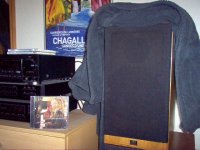..and so far I can understand..On the cat378, if you subtract the on axis response, you are 8db down 10khz vs 3khz 30 degrees off axis.
The dispersion may be like an 8" full range driver.
..cut...
..but from here I can't! Please would you explain to me this concept? What does it mean 7' and 12', how can you estimate these data from a response graph? Excuse me, what does it mean 80 watt receiver crossed at 200 hz? Please be patient with me..!Think 1 pair of ears at 7', 2 people (maybe 3) at 12'.
But on axis with the 5.6uf cap, it is 6db down at 2khz, 12db down at 1khz, no kufuffle where its Fs is, and deeper than a surface dome.
So you can do 6db time alignment / phase alignment if that is what rocks your boat.
And it can take 80 watt receiver (crossed at 200hz).
Andre,
I sit close to my tv.
So I need the highs to be 6’ wide at 7’ from the speaker.
I could aim the cat378 between the left and right seated people and it was ok.
My dome Morel cat308 (ordinary Dome tweeter) you could hear the tweeter at almost anywhere in front of the speaker. Horns add gain by taking the sphere of sound and narrowing where it goes, adding gain where the horn is controlling the sound).
The 6db time alignment phase alignment is a big argument, so I won’t get into that.
Usually receivers are rated in watts a channel, power, or how loud. Assuming they put that out, you can cross a speaker over to a subwoofer, allowing more power for midrange and sparkle.
Long story short, it is rugged tough tweeter that basically is crossed just under 5,000hz.
You can see on the cat 378 graph that directly into the horn dome tweet, you have a hump 1-4khz, then it rolls off (like someone turning the treble knob down on a receiver). The more you move to the right or left, you lose even more of the sparkle.
When you put the 5.6uf cap, it measures pretty flat, down 6db at 2khz, 12db at 1khz. But if you sit 7’ away, and are 3’ to the right of the center line to the tweeter, you lose some sparkle.
I sit close to my tv.
So I need the highs to be 6’ wide at 7’ from the speaker.
I could aim the cat378 between the left and right seated people and it was ok.
My dome Morel cat308 (ordinary Dome tweeter) you could hear the tweeter at almost anywhere in front of the speaker. Horns add gain by taking the sphere of sound and narrowing where it goes, adding gain where the horn is controlling the sound).
The 6db time alignment phase alignment is a big argument, so I won’t get into that.
Usually receivers are rated in watts a channel, power, or how loud. Assuming they put that out, you can cross a speaker over to a subwoofer, allowing more power for midrange and sparkle.
Long story short, it is rugged tough tweeter that basically is crossed just under 5,000hz.
You can see on the cat 378 graph that directly into the horn dome tweet, you have a hump 1-4khz, then it rolls off (like someone turning the treble knob down on a receiver). The more you move to the right or left, you lose even more of the sparkle.
When you put the 5.6uf cap, it measures pretty flat, down 6db at 2khz, 12db at 1khz. But if you sit 7’ away, and are 3’ to the right of the center line to the tweeter, you lose some sparkle.
Last edited:
Looking at cat378 response with the 5.6uf, I don’t see a reason to bother notching the fs. I remember reading something about 6db tweet crossovers needing To be 2.5 times or more the tweets fs so you don’t have to notch it out.
I like the 10" but don’t think it has enough directivity to be crossing 6db at 2khz.
And it will not be truly time aligned / phase aligned unless the coil and woofs natural roll off are combined 6db down at 2khz and 12db down at 4khz. If the woof is rolling at 6db, it adds to the 6db coil making the phase look like a 12db.
Again, you don’t have to be 6db time phase aligned to sound good. Many stereophile recommended speakers are not.
Don’t get me wrong, my 10" b102 and cat 378 worked, just narrower dispersion than I liked at 7’ listening distance. But bump the whizzer and it rips, don’t know if it was cats or grandchildren. It was simple project, woof run no coil, sounded real good, Very rugged, and would get loud as a 2 way 10” can.
I still have been thinking on a mtm 6.5" peerless to a dome (6db time aligned / phase aligned) but any Dunlavy review opinion says you need to be 10’ away minimum.
I’ve been buried reading Dunlavy posts and realizing there are good sounding speakers, bad sounding speakers, and there are accurate speakers.
Usually a dynamic, bassy, Detailed, or pleasing sounding speaker sounds “better” to one person versus another. Otherwise all women kiss the same, all burgers taste the same, and all wines taste the same.
I’m thinking we need multiple types of speakers, depending on mood, music, volume level, movies, etc.
I like the 10" but don’t think it has enough directivity to be crossing 6db at 2khz.
And it will not be truly time aligned / phase aligned unless the coil and woofs natural roll off are combined 6db down at 2khz and 12db down at 4khz. If the woof is rolling at 6db, it adds to the 6db coil making the phase look like a 12db.
Again, you don’t have to be 6db time phase aligned to sound good. Many stereophile recommended speakers are not.
Don’t get me wrong, my 10" b102 and cat 378 worked, just narrower dispersion than I liked at 7’ listening distance. But bump the whizzer and it rips, don’t know if it was cats or grandchildren. It was simple project, woof run no coil, sounded real good, Very rugged, and would get loud as a 2 way 10” can.
I still have been thinking on a mtm 6.5" peerless to a dome (6db time aligned / phase aligned) but any Dunlavy review opinion says you need to be 10’ away minimum.
I’ve been buried reading Dunlavy posts and realizing there are good sounding speakers, bad sounding speakers, and there are accurate speakers.
Usually a dynamic, bassy, Detailed, or pleasing sounding speaker sounds “better” to one person versus another. Otherwise all women kiss the same, all burgers taste the same, and all wines taste the same.
I’m thinking we need multiple types of speakers, depending on mood, music, volume level, movies, etc.
Last edited:
I think I can see where you're coming from, but I don't think that's how it works with waveguides. Perhaps you meant less nearby reflections, or the sound of a clear space around the speaker?Narrower dispersion, so less diffraction. I know this sound from cone tweeters.
My current opinion is waveguides have less baffle problems, being directional.
Power Response is not the same thing as Frequency response.
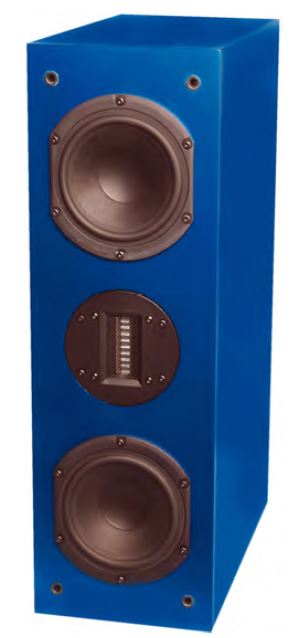
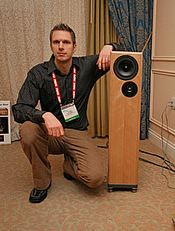
Both speakers are doubtless flat on frequency response. I would expect no less from competent designers.
But the top MTTM one just does it more effortlessly. Each midbass driver is actually working at 1/4 power for the same effect. Result: Less distortion. Simple as that. 😎
Unfortunately from here I've lost the thread.. since I can't still understand why power response is so important, maybe more important than on-axis response, I'd like very much to understand better ethese concepts. Please would you explain: does a narrower dispersion decrease power response?
What does it have to do waveguided tweeter's narrow dispersion with an MTM config?
Power Response is not the same thing as Frequency response.

Both speakers are doubtless flat on frequency response. I would expect no less from competent designers.
But the top MTTM one just does it more effortlessly. Each midbass driver is actually working at 1/4 power for the same effect. Result: Less distortion. Simple as that. 😎
I dug up some power response simulations aka energy frequency response in Boxsim:
3/4" tweeter:
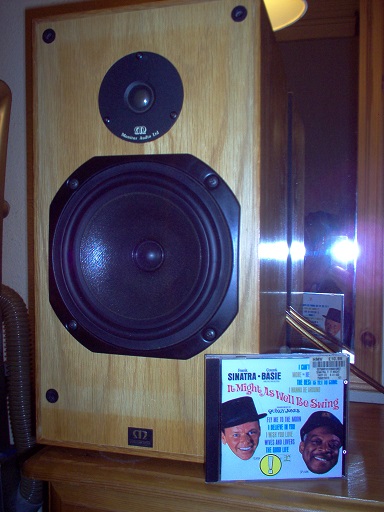
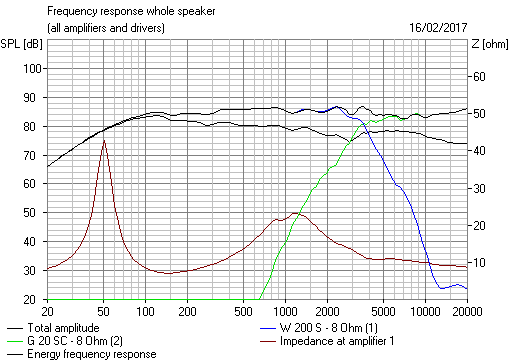
2" cone tweeter:
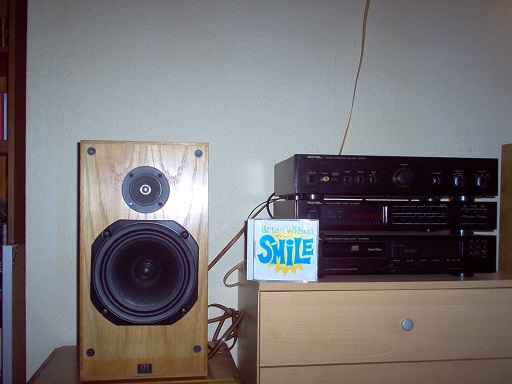
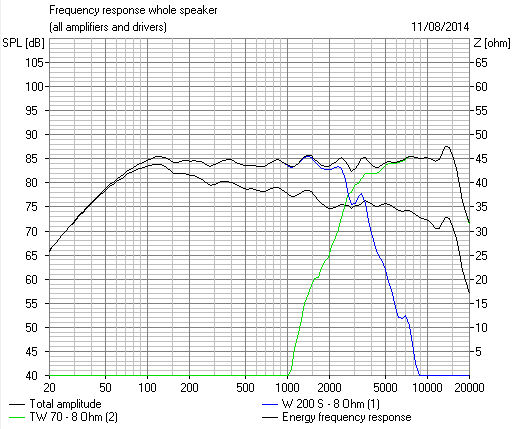
The simulator uses the size of the radiating area (Sd) to work this out. It also allows for the box edges which often produce big ripples around 3-5 kHz. There is an exagerrated power at bass frequencies due to box bafflestep too.
3/4" tweeter:
2" cone tweeter:
The simulator uses the size of the radiating area (Sd) to work this out. It also allows for the box edges which often produce big ripples around 3-5 kHz. There is an exagerrated power at bass frequencies due to box bafflestep too.
Very good example of Power response not being the same as frequency response. In the first example the power response dips around x-o, and then peaks octave above. With LR2 the dip is wider and gentler, and peak is smaller in magnitude comparing to LR4.
Hello, I'm here, my proposal was to be not until I've made some measurements about waveguide and baffle relationship. All measurement was made using the same driver unit ScanSpeak D2905-9500, 1 volt rms MLS dual channel gated method in ARTA, graphs dB scale forced to 90 dB average, 10 uF cap in series with driver, baffle made with the largest shoes-box I've found among my wife's ones..!
Let's begin with SS on baffle:
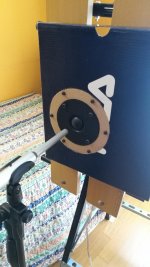
Here's the response at 100 cm (black trace) overlayed 5 cm one (grey trace):
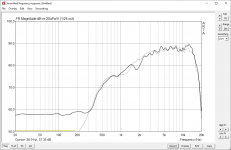
It's possible to see that with a quite good dimensions baffle like this there's not any particular problem but the 1,8 khz dip, so I understand that my previous baffle gave me horrible problems due to its dimension and quite certainly due to the slot between the highs box and the woofer box, that may explain that strange behaviour with two very near and deep dips around 3 khz);
SS on baffle through waveguide:
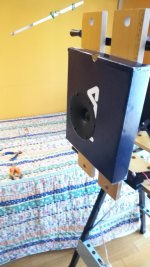
Here's the response at 100 cm (black trace) overlayed 5 cm one (grey trace):
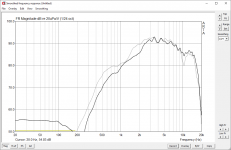
Certainly that represents a better situation than prevoius one because there's not its 1,8 khz dip, which ensures that waveguide leads less interactions between driver and baffle. I can imagine that here the difference due to diffraction is however not impressive because of the baffle quality, maybe with a worse baffle there would be major differences.
What impressed me is however the enormous gain that waveguide leaded to onaxis response, with a max of 6 db at 3khz while we can see a loss of about 3 db at the highest frequency around 15 khz. From this I can imagine that off axis response could decrease rather heavily going away from axis.
_______________________________________
I've made also some trial without baffle because that situation keeps on fascinating me from aesthetic point of view.
SS without baffle:
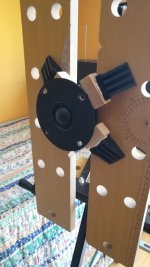
Here's the response at 100 cm (black trace) overlayed 5 cm one (grey trace):
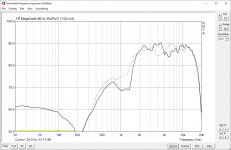
SS without baffle but with waveguide:
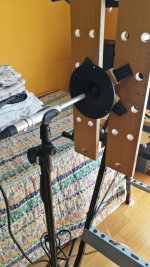
Here's the response at 100 cm (black trace) overlayed 5 cm one (grey trace):
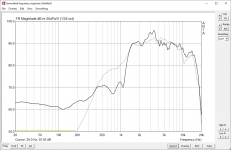
Comparing SS plus waveguide with (black) and without (grey) baffle at100 cm:
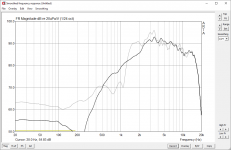
Comparing SS without waveguide with (black) and without (grey) baffle at 100 cm:
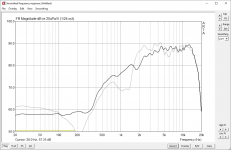
Unfortunately (for me) these results seems not good at all because it seems that waveguide didn't help much response when there's not any baffle; evidently, even if waveguide narrows the emission's solid angle, the missing of baffle makes itself feel with big strenght.
_______________________________________
It will follow new measurements session when I'll put a definitive (from geometrical only point of view because I'll use another shoes-box..) baffle to put on the bass tower, beginning the tuning of my 2 way idea. It will probably be a worse baffle than this one because a bit narrower, so maybe we'll be able to find some newer (and perhaps bigger) difference between with and without waveguide topology, so come with me if you want🙂
Let's begin with SS on baffle:

Here's the response at 100 cm (black trace) overlayed 5 cm one (grey trace):

It's possible to see that with a quite good dimensions baffle like this there's not any particular problem but the 1,8 khz dip, so I understand that my previous baffle gave me horrible problems due to its dimension and quite certainly due to the slot between the highs box and the woofer box, that may explain that strange behaviour with two very near and deep dips around 3 khz);
SS on baffle through waveguide:

Here's the response at 100 cm (black trace) overlayed 5 cm one (grey trace):

Certainly that represents a better situation than prevoius one because there's not its 1,8 khz dip, which ensures that waveguide leads less interactions between driver and baffle. I can imagine that here the difference due to diffraction is however not impressive because of the baffle quality, maybe with a worse baffle there would be major differences.
What impressed me is however the enormous gain that waveguide leaded to onaxis response, with a max of 6 db at 3khz while we can see a loss of about 3 db at the highest frequency around 15 khz. From this I can imagine that off axis response could decrease rather heavily going away from axis.
_______________________________________
I've made also some trial without baffle because that situation keeps on fascinating me from aesthetic point of view.
SS without baffle:

Here's the response at 100 cm (black trace) overlayed 5 cm one (grey trace):

SS without baffle but with waveguide:

Here's the response at 100 cm (black trace) overlayed 5 cm one (grey trace):

Comparing SS plus waveguide with (black) and without (grey) baffle at100 cm:

Comparing SS without waveguide with (black) and without (grey) baffle at 100 cm:

Unfortunately (for me) these results seems not good at all because it seems that waveguide didn't help much response when there's not any baffle; evidently, even if waveguide narrows the emission's solid angle, the missing of baffle makes itself feel with big strenght.
_______________________________________
It will follow new measurements session when I'll put a definitive (from geometrical only point of view because I'll use another shoes-box..) baffle to put on the bass tower, beginning the tuning of my 2 way idea. It will probably be a worse baffle than this one because a bit narrower, so maybe we'll be able to find some newer (and perhaps bigger) difference between with and without waveguide topology, so come with me if you want🙂
Last edited:
I just had a look in Boxsim Simulator at what happens with 104mm baffles, like a bare tweeter. Its inhuman brain seems to know what it is doing... 
Seemed the bafflestep point moved up to about 1.5kHz. Which is what you get.
But this sibilance or harshness issue with tweeters is mainly happening higher up IMO. And I still think the Morel CAT378 might be good.
Now I was never terribly fond of this soft-dome Morel CAT298 4th order speaker on a bare baffle:
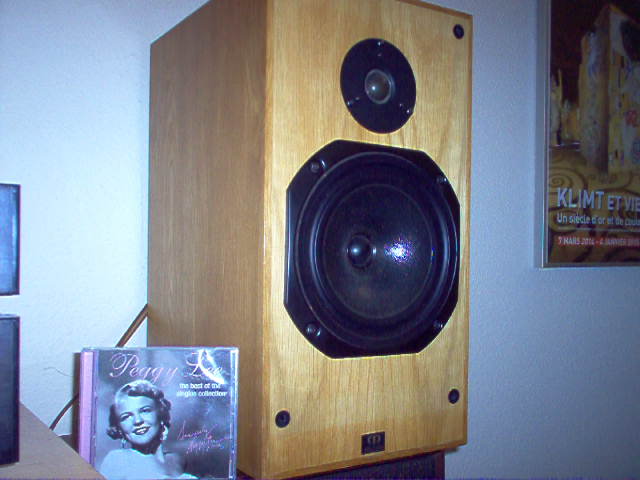
Much better with a grille cloth. But I thought it might be good to drape a heavy cotton bathrobe over them. There's not much wrong with the sound now. Rather smooth. 🙂

Seemed the bafflestep point moved up to about 1.5kHz. Which is what you get.
But this sibilance or harshness issue with tweeters is mainly happening higher up IMO. And I still think the Morel CAT378 might be good.
Now I was never terribly fond of this soft-dome Morel CAT298 4th order speaker on a bare baffle:
Much better with a grille cloth. But I thought it might be good to drape a heavy cotton bathrobe over them. There's not much wrong with the sound now. Rather smooth. 🙂
Attachments
I just had a look in Boxsim Simulator at what happens with 104mm baffles, like a bare tweeter. Its inhuman brain seems to know what it is doing...
Seemed the bafflestep point moved up to about 1.5kHz. Which is what you get.
But this sibilance or harshness issue with tweeters is mainly happening higher up IMO. And I still think the Morel CAT378 might be good.
...cut...
Exactly, and the bare tweeter solution even peaks in the 2-4 khz range than the baffled, so it's to abandone at all, maybe except cutting it at more than 4 khz, but this way is not possible crossing it with a 8''!
Boxsim is a wonderful application, I use it as reference simulator for its comprehensive calculation capabilities; unfortunately, as every simulator, its results are only a starting point, it will never say how good a project will effectively sound.
Hello, finally I think to have found the response to my answer about diffraction as possible source of my sybilance and harshness problem.
Diffraction creates a lot of problem and irregularities in response and we have seen it clearly in measurements, every of each was however useful for me to learn using instruments for designing and verifying a loudspeaker, for which reason I'm now happy to have spent time and money. But I think my problem is not diffraction, and we'll see why.
This is the result of the last step of my project:
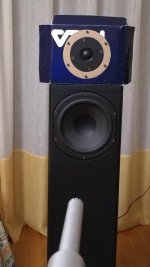
in this project I've learnt to measure drivers already mounted on baffle, simulating them with crossover and measure them again to verify results:
simulation
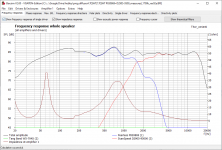
time aligned measured response
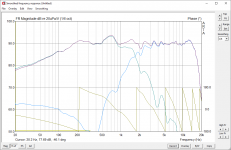
Not bad!
I can see it overalying this response with a reference brand loudspeaker's one:
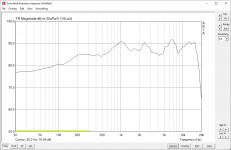
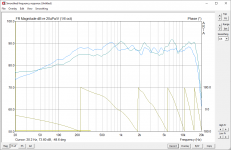
(blue line my project, green line reference loudspeaker)
But coming to listening, STILL REALLY BAD! Putting on my preferred Pearl Jam's "Elderly woman", ssssss are still in evidence and unpleasant, while this not happens sounding the same song from reference speaker, even if its 5-8 khz response is higher than mine. Not useful at all lowering high regions through digital spline equalizer.
Trying not to cry, looked for other measurement types in ARTA: distortion is quite regular, not bad; but what strongly struck me was Cumulative Spectral Decay, from which I think to have found explanation.
This is CSD of my reference speaker:
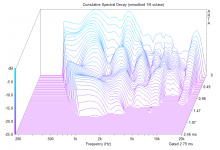
while this is CSD of my project:
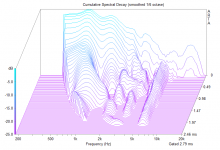
It's clear that there's a strange tweeter behaviour at 5 khz, just the sybilance frequency!
Let's see single driver's CSD, filtered and baffled on cabinet as they are in final speaker:
woofer
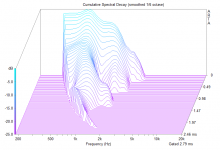
and... TWEETER!!
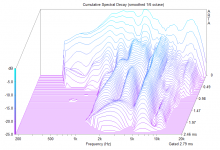
What a disaster!! Tweeter rings like a bell at certain frequencies!
So the question arises spontaneously: may my tweeter be damaged? May ferrofluid oil dried out? In this last case, is there a method to refill oil? Can I say now that my problem is not diffraction but a not properly working tweeter?
What I didn't understand at all is why tweeter works more badly if alone and less badly if together with woofer, even if filtered with the exactly same crossover?
Thank you.
Diffraction creates a lot of problem and irregularities in response and we have seen it clearly in measurements, every of each was however useful for me to learn using instruments for designing and verifying a loudspeaker, for which reason I'm now happy to have spent time and money. But I think my problem is not diffraction, and we'll see why.
This is the result of the last step of my project:

in this project I've learnt to measure drivers already mounted on baffle, simulating them with crossover and measure them again to verify results:
simulation

time aligned measured response

Not bad!
I can see it overalying this response with a reference brand loudspeaker's one:


(blue line my project, green line reference loudspeaker)
But coming to listening, STILL REALLY BAD! Putting on my preferred Pearl Jam's "Elderly woman", ssssss are still in evidence and unpleasant, while this not happens sounding the same song from reference speaker, even if its 5-8 khz response is higher than mine. Not useful at all lowering high regions through digital spline equalizer.
Trying not to cry, looked for other measurement types in ARTA: distortion is quite regular, not bad; but what strongly struck me was Cumulative Spectral Decay, from which I think to have found explanation.
This is CSD of my reference speaker:

while this is CSD of my project:

It's clear that there's a strange tweeter behaviour at 5 khz, just the sybilance frequency!
Let's see single driver's CSD, filtered and baffled on cabinet as they are in final speaker:
woofer

and... TWEETER!!

What a disaster!! Tweeter rings like a bell at certain frequencies!
So the question arises spontaneously: may my tweeter be damaged? May ferrofluid oil dried out? In this last case, is there a method to refill oil? Can I say now that my problem is not diffraction but a not properly working tweeter?
What I didn't understand at all is why tweeter works more badly if alone and less badly if together with woofer, even if filtered with the exactly same crossover?
Thank you.
Last edited:
For the same reason you'd get more accessible data in your last CSD if you equalised the initial response.why tweeter works more badly if alone and less badly if together with woofer,
Play with the starting point in the gated measurement to get similar frequency response in the CSD top curve as the measured axis frequency response.
Play with the starting point in the gated measurement to get similar frequency response in the CSD top curve as the measured axis frequency response.
Indeed I've found that CSD results changes rather between two measurements made in the quite same conditions, please be patient, if I understood, the curve further back/far of CSD must look as much as possible like the on axis response curve? If this graph (referring to tweeter filtered) wrong because tweeter doesn't go so low in frequency?
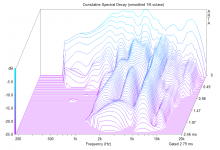
How can I play with starting point in CSD?
Another question, if tweeter has dried ferrofluid, wouldn't it have a strange behaviour in the resonance frequency region and show a different impedance curve from the original one? How can missing oil affect only a so narrow 5 khz region? Impedance curve is exactly the same of its datasheet.
Thank you.
Last edited:
You need to use time-gated measurement for proper loudspeaker CSD analysis, so the starting and ending point of the gating must be set correctly. If the points are not correct, the result can be very confusing.
Too bad you can't get outside to do measurements - damn Mexican beer. Unless you can use roof of the place where you live. But seriously, you would get cleaner measurements if the spkrs can be placed away from surfaces, 2m on the top of the lather. Anyway the CSD look strange to me. I use old very CLIO, REW and never seen something like this. As for the ferrofluid, open the tweeters and check. If you cross the tweeters high they could work without f-f, they could even be faster. Last time I used 30yr old Vifa Alu tweeters they sounded unnatural but f-f wasn't dried up, (???). You have some resonance from the mids but you should be OK, I would stop trying to get flat freq resp after x-o point but rather keep the tweeter level lower - it's very rarely that I heard naturally sounding spkrs that were ruler flat, unless very carefully optimized for flat Power Response, most have sort of BBC dip to compensate for rise in tweeter directivity and dip at x-o point.
- Home
- Loudspeakers
- Multi-Way
- May my problem be diffraction?
